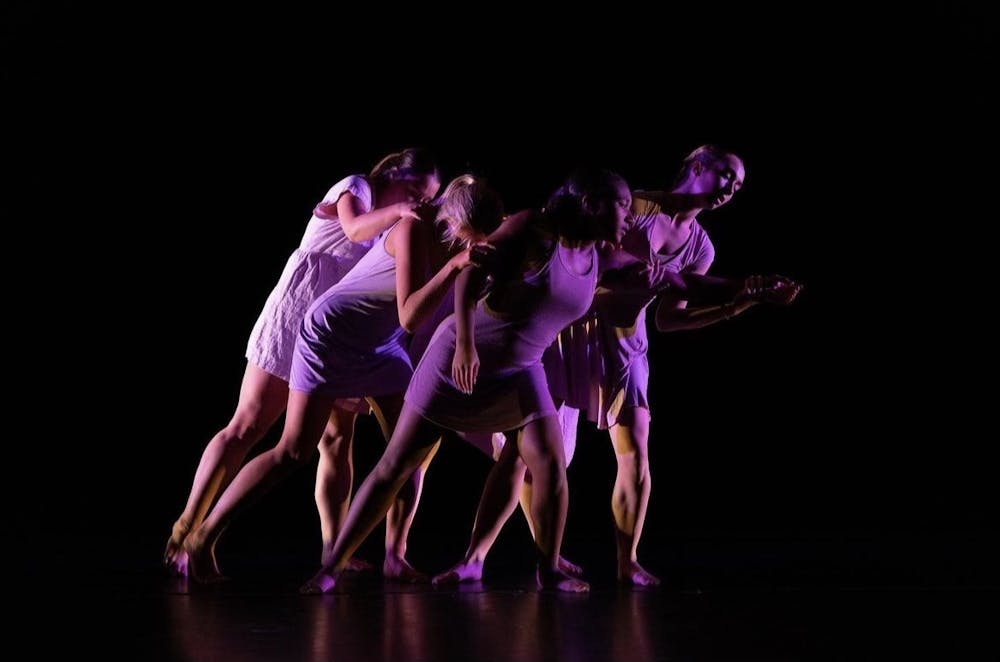As viewers settled in their seats at the Ruth Caplin Theatre, the hall lights dimmed, leaving a single spotlight on a group of dancers on stage. A moment of stillness blanketed the theater, and then the ensemble began to move. Using smooth, graceful motions, the group danced initially in silence. The quiet was broken up only by intermittent words and phrases uttered by the dancers in a manner reminiscent of dialogue in a play. This dance, titled “Here is Sanctuary,” was the opening performance of the Spring Dance Concert, presented by the University Department of Drama’s dance program.
The concert’s ensemble consisted of 22 dancers and six choreographers, each with varying levels of involvement in the University and its dance program. All of the performers were students — several of whom are pursuing majors in drama or minors in dance. The choreographers included fourth-year College students Lydia Driggers and Alyssa Kelley and fourth-year Education student Emily Taylor as well as two University faculty members — Assoc. Dance Prof. Kim Brooks Mata and Asst. Dance Prof. Katie Schetlick. The event also featured choreography from Ronya-Lee Anderson, a Caribbean-American singer-songwriter and dancer-choreographer.
“Here is Sanctuary,” choreographed by Anderson, continued with a section accompanied by a percussive and reverberant soundtrack. The motions at this stage in the dance were clearly symbolic, giving each dance a feeling of undeniable theatricality — for instance, the performers would place their hands together as if to pray, a clear representation of the theme of sanctuary — a testament to the influence of the Department of Drama. As the lights dimmed to black, signaling the end of the piece, the performers continued to move, creating the impression of the dance continuing indefinitely.
The second piece of the evening occurred not on the stage, but the screen, as a video played on a wide screen at the back of the theater. Titled “commander,” the video displayed two identical kitchens, each complete with a stove and countertop. The digital presentation may have puzzled viewers initially, though such confusion was quickly dispelled as a performer dressed in a white button-up and pants entered the kitchen on the left.
Utilizing props including a knife and a saucepan, the performer — resembling a husband — began a delicate dance in the kitchen, moving their hands lightly between the objects. Throughout the dance, the kitchen on the right side of the screen remained stagnant — that is, until the same performer entered wearing a blue dress with white polka dots. Resembling a wife, the dancer began a second, complementary dance.
When the husband moved elegantly and delicately, the wife danced aggressively and jarringly — wildly opening the fridge door, forcefully reaching for cups in a drawer and irritably grabbing food from the microwave. The stark contrast between the two dances combined with the unorthodox setting hinted at a larger commentary on the relationship — the dances, like the husband and wife, were incompatible.
As in the opening dance, there was an indisputably dramatic quality to “commander,” as the kitchen replaced the dance floor and conventional dancing was swapped for gestures suggestive of cooking. Though the performance was unexpected and initially even bizarre, it certainly emerged as a cohesive and inventive piece — marking it a stand-out performance of the evening.
For the concert’s third selection, “a very thin line,” a trio of dancers began with a brief but graceful opening before being joined by two additional dancers. In this performance, the visual was particularly important — the dancers turned their bodies and drew circles with their arms and legs significantly throughout the piece.
The dance sought to capture the pain of an abusive relationship, according to the program notes. This theme was certainly captured in the choreography, which relied greatly on the visual motif of rotation. During the piece, a group of five dancers turned their bodies and drew circles with their bodies, evocative of the emotional turmoil endured in a toxic relationship.
The selection was also a testament to the masterful way in which the performers utilized space. Throughout the dance, they traveled from one side of the stage to the other, directing the focus of the viewers across the floor. In addition to the performers’ use of space, their faces were also particularly evocative — at the end of one sequence, the performers froze with agitated expressions, a further testament to their ability to blend dance and theater.
Titled “Ticket to Anywhere,” their fifth performance was the artistic climax of the evening. Featuring the largest ensemble yet of nine dancers, the attention to the visual aesthetic of the dance was particularly apparent. Both the performers’ costumes as well as the background lighting were warm shades of red-orange, lending a vibrancy to an already dynamic dance.
Stylistically, the piece was the closest to contemporary dance, featuring faster and sharper movements. The performance also included considerable interplay between dancers — in one section, the ensemble formed a circle before one of the dancers departed into the wings of the theater, perhaps claiming their own “ticket to anywhere.” The music and movement synergized remarkably in this piece, and a series of coordinated, rhythmic sequences from the dancers produced a visual and emotional catharsis for the audience, generating an especially fierce round of applause.
The last dance of the night, titled “what the wings hold,” began as a group of six dancers slowly entered the stage from under the right curtain of the theater. According to the program, this performance was based on a series of improvisational prompts viewed by the performers before each show. This experimental quality became increasingly clear as the performance evolved.
Though the ensemble was initially unified, a later section called for the dancers to move in pairs, with each duo’s dance growing apart from the others. While one pair spun with their arms linked, another took turns moving, as if in a choreographic conversation.
The dance concluded as it began, with the dancers slowly slipping, one by one, under the right curtain. In the background, “We’ll Meet Again” by English singer Vera Lynn played, a vintage song from 1939. As the final dancer began to slide on their stomach under the lowered curtain, the spotlight lowered and focused on them, dimming to nothing as the performer disappeared.
During a season populated by various dance concerts all across the University, the Spring Dance Concert offered a level of drama unseen in other performances on Grounds. From its compelling choreographic dialogue to the thematic costume selection, each dance in the concert maintained an individual artistic voice — but one rooted squarely and unabashedly in the theater.







